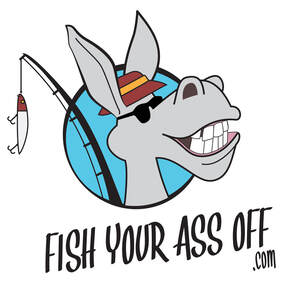
Fishing Catch and Release Ethics and Techniques
I get lots of questions about how to handle a fish when you catch them. You have to do all that you can not to harm any fish that you are not planning on eating. Inshore fish populations have declined significantly in the last 6 or 7 years because of poor water quality, over harvesting and many other causes.
SO when you are keeping fish you don't have to keep your limit every time. Leave some for our kids and grand kids.
All of us fishermen want to have tons of fish around to catch and it only makes sense to be careful with the ones that we don't plan on keeping right?
This article is all about the proper techniques, tools and procedures to ensure that you don't kill any fish that you are not going to eat.
This photo of the fisherman with the gator trout shows you the perfect way to handle a fish for a quick picture and release. He uses a fish grip to secure the jaw and supports the fish in the midsection. This helps ensure that he doesn't injure its jaw or internal organs too much.
Fish mortality is a big deal for me because I am a kayak fishing guide on the Treasure Coast of Florida. I have been fishing the grass flats and oyster bars all over Florida for more than 40 years. I make a living on the water and have seen the numbers of fish decrease steadily over the last decade or so.
In the article below we will talk about all of the ways that you can decrease the number of fish that you accidentally kill so that everyone can enjoy catching fish for many years to come.
Watch this video first.
I get lots of questions about how to handle a fish when you catch them. You have to do all that you can not to harm any fish that you are not planning on eating. Inshore fish populations have declined significantly in the last 6 or 7 years because of poor water quality, over harvesting and many other causes.
SO when you are keeping fish you don't have to keep your limit every time. Leave some for our kids and grand kids.
All of us fishermen want to have tons of fish around to catch and it only makes sense to be careful with the ones that we don't plan on keeping right?
This article is all about the proper techniques, tools and procedures to ensure that you don't kill any fish that you are not going to eat.
This photo of the fisherman with the gator trout shows you the perfect way to handle a fish for a quick picture and release. He uses a fish grip to secure the jaw and supports the fish in the midsection. This helps ensure that he doesn't injure its jaw or internal organs too much.
Fish mortality is a big deal for me because I am a kayak fishing guide on the Treasure Coast of Florida. I have been fishing the grass flats and oyster bars all over Florida for more than 40 years. I make a living on the water and have seen the numbers of fish decrease steadily over the last decade or so.
In the article below we will talk about all of the ways that you can decrease the number of fish that you accidentally kill so that everyone can enjoy catching fish for many years to come.
Watch this video first.
No stainless steel hooks
Come on. Why would you use a stainless steel hook? They will literally stay in that fish for years. A rust out hook will only be in the fish for a couple of weeks. Please do not use stainless steel hooks. They don't catch more fish and the kill tons of fish every year.
Switch your treble hooks for single hooks.
Most fishing lures come with treble hooks when you buy them. I assure you that you do not need treble hooks on lures to catch a lot of fish. My lures go through a progression from fully treble hook to less treble hooks to single hooks.
Here is what I mean. If I buy a walk-the-dog type of top water lure they usually come with 3 sets of treble hooks. I will immediately take out the middle one. Once the other two start to get too rusty I will replace them with inline single hooks. Then from there they will always get replaced with inline single hooks.
Trust me when I tell you that if you become a good fisherman, then you will not miss many fish because you switched from treble hooks to single hooks.
Watch the video below to see a great trout fishing day using single hook jigs.
Step four- Use the right tools.
You have to get yourself a pair of fish grips, a de-hooker and a good pair of needle nosed fishing pliers. The right tools will make it easier to remove hooks from the fish quickly and efficiently.
If your fish swallows the hook, then just cut the line. Do not try to get your hook back. The fish has a much higher probability of surviving it you cut the line.
If you like to use a landing net, then get the rubberized netting ones. They keep the fish from losing too much of their protective slime coat.
Step five- Handle fish correctly.
If you don't have to take the fish out of the water to release it then don't. Of course if you want a photo or video of the fish then handle it ethically and then release it as quickly as possible.
Always wet your hands before handling a fish. Fish have a protective coating of slime that keeps them from getting infections and makes them glide through the water more efficiently. We all forget to do this step sometimes but try to remember this one because it is important.
When you take a picture make sure to support the fish in its midsection as well as by the jaw. This decreases the chances of damaging the jaw and/or the inner organs of the fish.
Check the rules of handling fish with your local state agency. You can get a BIG fine for handling certain fish incorrectly.
For instance, in Florida, you cannot pick a tarpon up out of the water if it is over 40 inches in length.
Step six- Reviving the fish.
You have to make sure that your fish is capable of swimming away before letting them go. Fish need to have oxygenated water flow over their gills to breathe.
Imagine that you just ran five 50 yard wind sprints and then someone immediately threw you in a lake. How well would you be able to swim. You could easily drown because you were already oxygen deprived before you were thrown in the lake.
That is exactly what it is like to release a fish after a long fight without reviving it first. They need water flow over their gills so if you release a fish before it gets its "breath" back then it will sink to the bottom and die.
It's very easy to do. Just face the fish into the current and let the water move over its gills if you are anchored.
If the boat is not anchored and there is not current just put the boat in gear to force the water over the fish gills. If you are wade fishing just move the fish through the water until it can swim off....
Please take the time to revive the fish that you catch until they can swim off on their own power. There will be a lot more fish for all of us to catch in the future if you do.
Conclusion:
Fishing is fun and we want to keep fishing as long as we can. If we don't start to protect our fisheries, then they might not be here for much longer. The point of this article is to help all of us fishermen think about the long term sustainability of our natural fishing resources.
I used to take these resources for granted until I noticed how quickly the fisheries around Florida are being depleted. There are sea trout spots that I fished just 5 years ago where you could catch 3 dozen trout in a few hours. Those same spots today will only yield 4 or 5 fish on a good day.
Every fish that we do not accidentally kill might lead to thousands of more fish being born. If we just keep one less fish or accidentally kill one less fish on every fishing trip, then there will be thousands more fish for us and everyone else to enjoy for years to come.
Thank you for reading this article.
Do you like how to fishing articles like this one? If you do, then sign up for our email list below because we will send you a new article every week. Sign up now and get your first article today.
